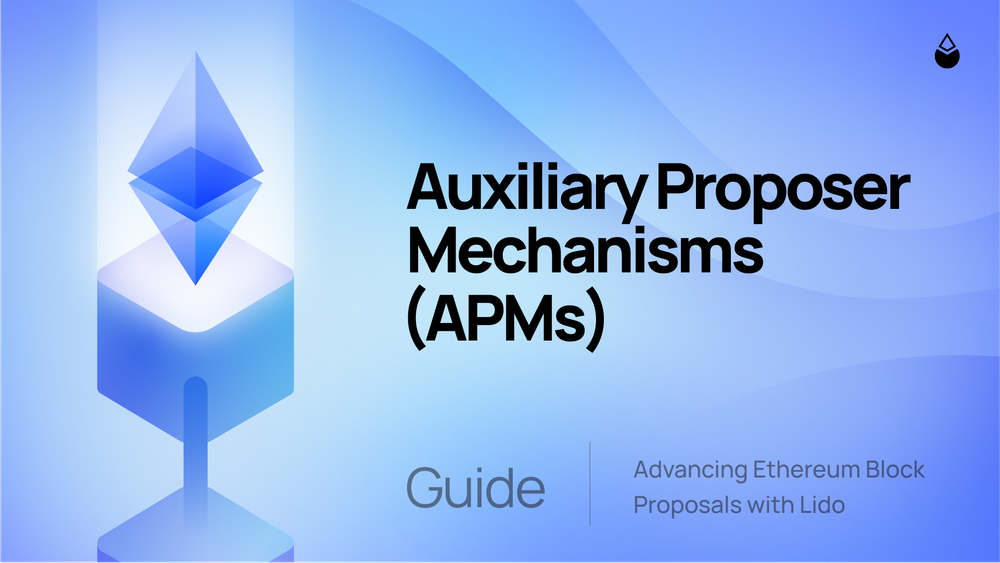Advancing Ethereum Block Proposals with Lido: A Simple Guide to Auxiliary Proposer Mechanisms (APMs)

Ethereum is constantly evolving. As new upgrades and ideas roll out—like Proposer-Builder Separation (PBS) and preconfirmations—the ecosystem becomes more powerful, but also more complex. For Node Operators and staking platforms like Lido, staying ahead means adapting to these changes without compromising decentralization, efficiency, or rewards.
That’s where Auxiliary Proposer Mechanisms (APMs) come in. Let’s break down what they are, why they matter, and how Lido is introducing them responsibly.
What Are APMs?
Auxiliary Proposer Mechanisms are a proposed framework that helps Lido safely explore and adopt new tools related to block creation on Ethereum. These tools are part of Ethereum’s evolving architecture, especially around how blocks are built and transactions confirmed.
Think of APMs as a structured approach to testing innovations like:
- PBS (Proposer-Builder Separation) – Separates the role of proposing blocks and building them
- Preconfirmations – Offers quicker assurance that a transaction will be included
- Advanced block markets – Creates new competitive dynamics for maximizing block rewards
By carefully evaluating these mechanisms, Lido ensures that Node Operators and stakers benefit from increased profit and specialization without introducing unnecessary risks.
Watch - Lido Contributor Gabriella Presents APM’s on NOCC #27

Breaking Down APMs: The Three Layers
The APM framework is made up of three core components:
- Mechanisms – The high-level concept (e.g., PBS, preconfirmations).
- Protocols – The specific technical designs for implementing mechanisms (e.g., MEV-Boost, Bolt).
- Sidecars – Software tools that support protocols (e.g., MEV-Boost, Commit-Boost).
Simple analogy:
Mechanism = big idea
Protocol = instruction manual
Sidecar = helper tool to run it
This modular setup allows for flexibility—different tools can be combined and tested without disrupting the core Ethereum software.
How Lido Ensures APMs Are as Secure as Possible
To avoid risks, APMs must pass through a structured rollout pipeline:
Step 1: Preparation
For consideration, APMs must have clear documentation, a performance tracking system, a rewards-sharing model, and third-party security reviews (if possible).
Step 2: Community Signal
A PERCH proposal is submitted, gauging Node Operator interest. Ideally, a level of testing is already done outside Lido infrastructure.
Step 3: Testnet Period
The APM must run on testnet for at least 1 month, with a sufficient number of validator keys participating and clear success criteria.
Step 4: Security Review
The community and Node Operators assess the APM from a security perspective and discuss mitigation plans for any risks found.
Step 5: Gradual Rollout
If all checks are passed, the APM Committee greenlights a gradual deployment, starting with willing Node Operators.
Updating the Block Proposer Rewards Policy
To align incentives, Lido is working on a proposal to revise the Block Proposer Rewards Policy. This ensures Node Operators using APMs do so transparently and in ways that benefit stakers, Node Operators, and the protocol.
Why It Matters
Ethereum’s block production landscape is shifting. This framework will give Lido the tools to navigate this terrain confidently, unlocking new efficiencies and potential rewards, without compromising on decentralization or safety.
And it’s not just a top-down process. Lido is inviting Node Operators, researchers, and community members to help shape how these tools are evaluated and adopted.
Join the Conversation
The future of Ethereum block production is being written now. Whether you’re running nodes, staking ETH, or building protocols—your feedback matters.👉 Visit the original APM framework mechanisms proposal.
👉 Visit the Node Operator Portal for APMs to dive deeper, share insights, or participate in testing.